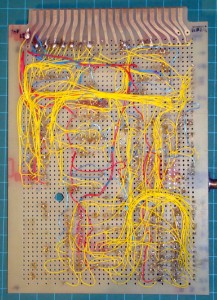At most universities and colleges, course costs are fixed, like airfares in the days before deregulation. But what would happen if we set course registrations using variable pricing?

I’ve been sitting on an ad hoc committee to look at ways the university can make better use of its resources. We’ve investigated suggestions that range from closing the studios at nights (not a popular option for the student union) to eliminating this or that service or department. My own parsimonious character is quite open to all these suggestions, but in the most recent meeting I made a rather off-the-wall comment that went something like this:
I know that we’re looking at practical and immediate ways to save money, and what I have in mind would require a capable student information system [Laurelle, our Registrar, closes her eyes and nods ruefully], but I wonder if we could step back for a moment and stop looking at our school as a university and consider it from the point of view of the hotel or airline business. These two industries know how to use resources and capital better than anyone.
Like an airline, we have airplanes (classrooms), we have ticketing and reservations systems (Registrar), we have pilots, attendants and mechanics (profs, technicians and administrative assistants) yet some of our planes (classrooms) fly half-full. An airline would have been bankrupt long ago.
So why don’t we try to maximize our capital stock, like an airline? When an airline has a half-empty airliner, they have a seat sale. Why don’t we do the same with our courses—give a classroom seat at a lower price to fill the class?
Everyone around the table smiled, as they are apt to do when someone who doesn’t talk much opens his mouth—they were curious to hear pretty much anything from me. Then my colleague Pam Ritchie replied that she didn’t think students would like it if they found out that the student beside them got the course for half price. I hadn’t thought of that, Pat. There were murmurs of agreement around the room, and the discussion moved to the next suggestion.
Fairness is Most Fair to the Ones Who Benefit the Most
I’m content to throw my bread on the waters in this manner; it has returned to me several times in the past few days. I’ve thought about Pat’s objection, and I don’t think that things would work that way. The NSCAD ethos dictates that we should treat everyone fairly; we don’t have differential fees (a Ceramics program is much more costly to run than a Design program, but students in both programs pay the same). I’m sure that I’m not the only one who has observed that fairness is most fair to the ones who benefit the most. So the idea of variable course fees is a complete non-starter at NSCAD.
Ok, so this is just an obscure blog… let’s play this out for a minute: students—and most staff and faculty—would object to the idea of variable course pricing on the basis that it is fundamentally unfair. Is it? And would this objection continue in practice?
Everyone Hates the Airlines, But Nobody Complains About their Seat-sale Deals
Let’s look at the airlines. Even though people love to hate Air Canada, I don’t think I’ve ever heard anyone complain about the fact that they got a good deal on a seat sale; neither have I ever heard anyone complain that they paid full fare while others paid less. Why would students behave any differently than the flying public?
Personally, I don’t feel badly when I pay for a reserved seat on a plane (or make a hotel reservation), knowing that their pricing schemes allow for the possibility that others are getting a cheaper rate for the same service. Why is this different than, say, a bicycle purchase—if I buy a bicycle for $300 and the next day it goes on sale for $250, shouldn’t the store have told me to wait until tomorrow to take advantage of the sale?
What’s going on here? On reflection, there are two important distinctions:
- A bicycle is a durable good, while the hotel stay or airline flight is an experience.
- When I reserve a hotel room, I’m paying not just for the room. I also receive the right of first refusal of that room on that night, and if I do decide to stay there, the cost is locked-in. Even if a busload of millionaires breaks down in front of the hotel at 11:30am on that night, the room is mine, at that price.
Education Is Not a Durable Good
Not only is it NSCAD the institution that prices its services as though they are physical commodities, it’s also some students who adhere to this misapprehension: “I have paid my tuition, now show me what I need to get a job (or get my credential).” The wiser and more mature students understand that education is an experience and that what you get out of it is in direct proportion to what you put in. And the value of a course to one student may be very different than the value to another student. For example, a student who has procrastinated enrolling in a required 2000-level Art History course until their final semester values this course much more than a second-year student. Should the fourth-year student pay more?
The Value of Reservations
Every good hotelier knows that there is a base cost to each room in her hotel, and that an empty room is a money loser. That’s why she is delighted to partner with reservation services like priceline.com—she can still make money even if she gives it away at half price. The customer who gets the deal (“shop for discount travel!” says the website) is delighted that he saved money. He is not thinking that he perhaps will pay more than another hotel customer.
But what about the customer who paid more? I’m a cheapskate, but I have my preferences. Say I like a particular hotel in New York, and I know that I’m going there in two months. I could wait until the day before I leave, go on the web and get a fantastic deal, or maybe the hotel is full, and I’m shut out. So if I want the assurance that I will get the room in the hotel I like, I pay more for the privilege. I’m happy with my $170-a-night room, and the person who pays $100 at the last minute for the room next to me is happy too.
The Benefits of Variable Pricing
Why would we want to charge differently for the same course at a different time, and what benefits, if any, would there be to students and the university?
Currently, students register for Fall and Winter semester courses starting in late March. They are encouraged to register early so that they can get into the courses they want. Latecoming students may not be able to get into the more popular courses. The less popular courses are cancelled by June. The university cannot keep a course on the books, hoping that it will fill, because if a course is cancelled past a certain date, the university pays the instructor a large fee for being available, even though the course is cancelled. Students are inconvenienced by a tyranny of the popular; only the well-subscribed courses will run, and the less popular ones are cancelled. These courses may be wonderful, and there are students who want them, but because these students are in a minority, they run rarely if at all.
If we consider variable pricing, we could start out by offering students a package deal: register early for a full load and get 20% off the per-credit price! When class numbers settle out, and it is apparent that certain courses have low enrolments, the cost of these courses could be lowered: while quantities last, these courses are half-price! For students who wait too long, the popular courses that are almost filled are priced higher.
The result: courses that would normally be canceled gain enough students to run, and the university uses course pricing to moderate demand. Classrooms are fuller, and course offerings are more predictable.
In the past, this kind of behaviour appeared unseemly, but I think that those public institutions with looming deficits need to start thinking a little differently about what they do and how they do it.


